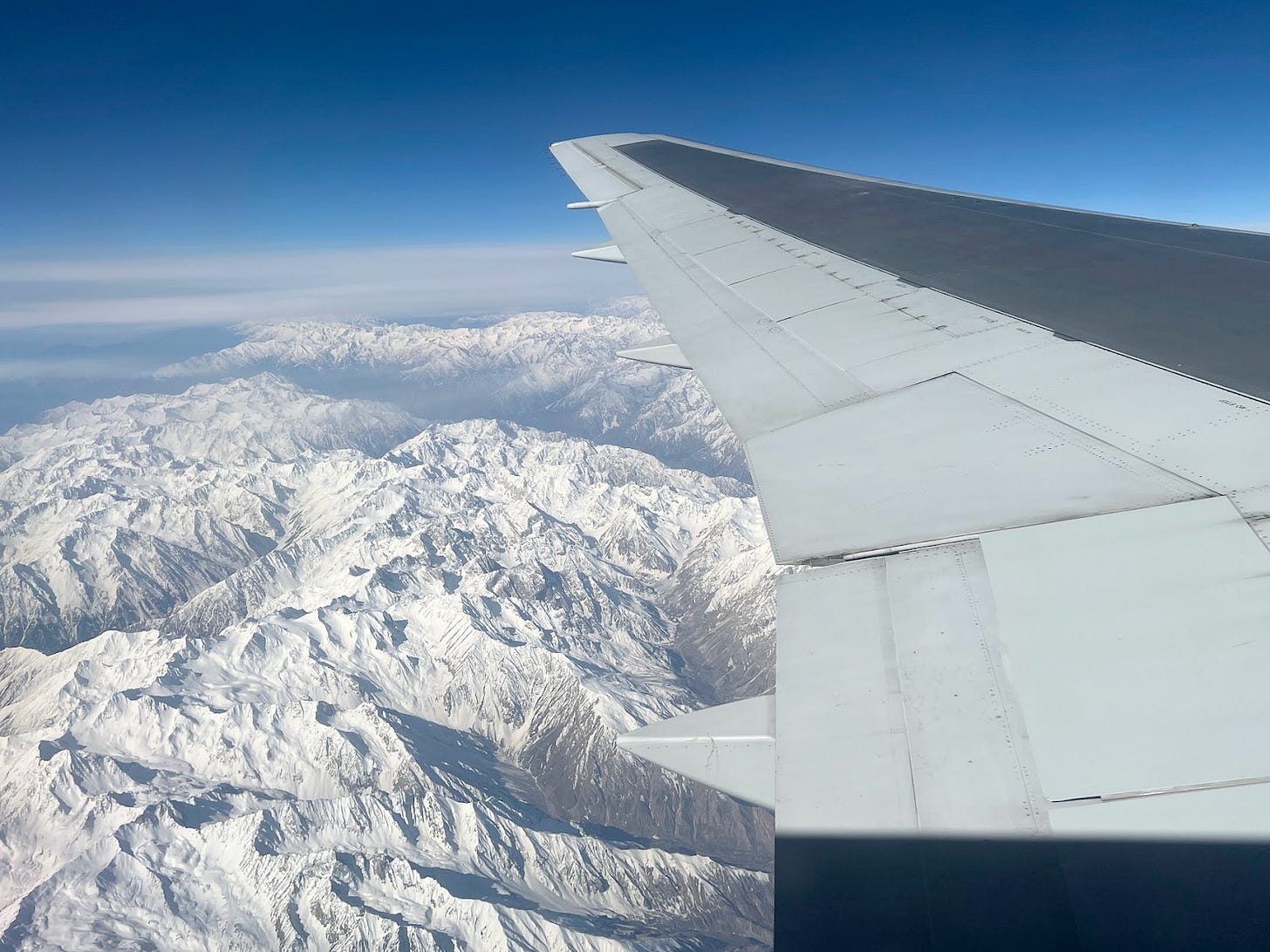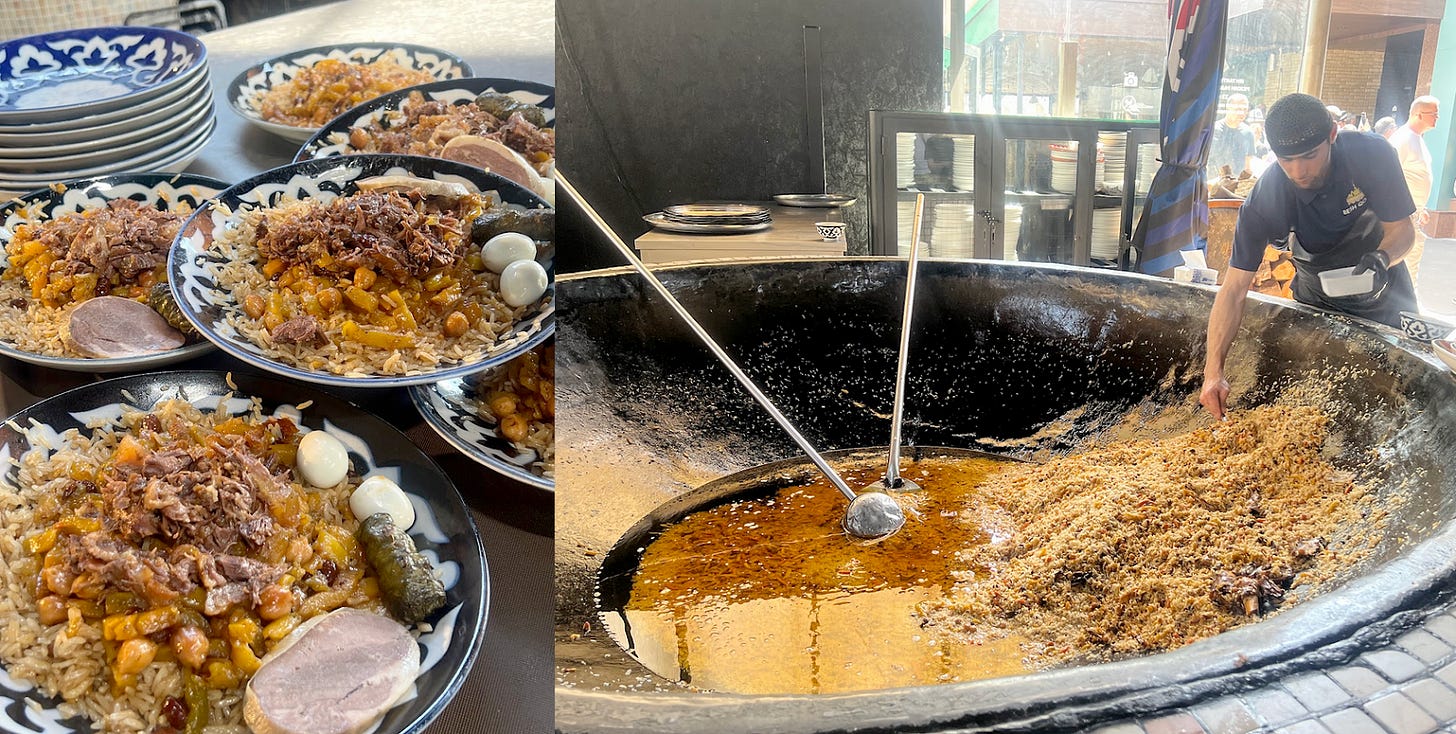Timurid Echoes Meet Soviet Streets in Tashkent
A Historical Exploration of Uzbekistan – Part I.
Blue mosaic tiles, majestic domes, and centuries-old architecture. Ancient spice routes and landscapes that look like paintings. Mouthwatering meat dishes and bread. Central Asia has lived in my imagination for over a decade but each time I tried to plan a trip, life got in the way. This year, I was determined to make it to at least one country on my bucket list: Uzbekistan. With my mother joining me and my brain running on low planning energy amidst work commitments, I decided to sign up for an organized group tour recommended by a friend.
Rameen of City Tales has been conducting history tours and city walks for some time now. I hadn’t heard of him before, and I think my friend forgot to mention it would be a history-focused tour, so the heavy doses of history felt a bit overwhelming at first. However, it turned out to be a blessing because we got a solid overview of the major events, dynasties, and rulers of Central Asia, and particularly Uzbekistan.
The excitement of finally setting foot in Central Asia kicked in when we were still mid-air. I was glued to my flight window as we flew over the snow-clad Hindu Kush mountain range. Glittering in white, it felt like a scene out of Game of Thrones, and all I could think of were how rulers like Babur crossed these rugged mountains on horseback to conquer new lands.
Over the next ten days, we visited Tashkent, Samarkand, Bukhara, Shahrisabz, and Khiva. Each place had its own charm and I can’t wait to share more. First up, let’s dive into Tashkent, the capital of Uzbekistan.
A Brief History of Tashkent
Tashkent is a modern metropolis with roots dating back over 2,000 years. Like most cities of Uzbekistan, it has seen its fair share of empires and invasions. To give you a brief overview, it was a part of the Persian Achaemenid Empire in 6th century BCE and saw the arrival of the Arab Caliphate in the 8th century, bringing Islam to the area. During the 9th to 12th centuries, Tashkent flourished under various Central Asian dynasties like the Samanids and Karakhanids, becoming an important center of trade, culture, and learning. However, the city suffered massive destruction during the Mongol invasions in the 13th century under the ferocious Genghis Khan. In the 14th century, Tashkent rebounded under Timur, becoming a vital Silk Road hub. The city remained important through the Shaybanid dynasty in the 16th century, maintaining its status as a cultural crossroads.
Fast-forward to the 18th century, the Kazakh Khanate struggled with internal divisions and external threats, and some Kazakh leaders invited the Russian Empire for assistance, hoping to stabilize their rule. However, Russia's involvement quickly shifted from support to domination. By the mid-19th century, Russia had expanded its control across Central Asia, and Tashkent was one of the first cities they captured. The Russian conquest dismantled the Khanate system, leading to widespread upheaval across Kazakhstan and surrounding regions. What began as a request for help to solve internal issues ultimately resulted in the full integration of Kazakhstan and Central Asia into the Russian Empire, with lasting political and cultural consequences.
Tashkent was chosen as the capital of the Republic of Turkistan in 1918 due to its strategic location, historical significance, and the fact that it was already an important cultural, commercial, and administrative center in the region. In 1924, the Soviet government restructured the region, creating several smaller republics based on ethnic lines, including the Uzbek SSR, Turkmen SSR, and others. Tashkent was made the capital of the Uzbek Soviet Socialist Republic (Uzbek SSR), which later became the independent nation of Uzbekistan after the Soviet Union collapsed in 1991.
Today, Tashkent boasts of cosmopolitan culture, modern infrastructure, and shiny skyscrapers. Islamic heritage sites exist alongside Soviet-era architecture, offering an interesting mix of different worlds.
Exploring the Modern Metropolis
We had a little over two days to explore Tashkent, a day and a half at the start of our trip and a day at the end. We covered a handful of places following Rameen’s lead, ranging from the historic to the modern.
We visited the Hazrati Imam complex, considered the religious heart of Tashkent and home to the Tillya Sheikh Mosque, Barakhan Madrasa, and the Imam al-Bukhari Islamic Institute. The complex was built near the grave of Hazrati Imam, the first imam-khatib of Tashkent, a scholar, poet, artist, locksmith, and one of the first Islamic preachers in Tashkent. The most remarkable features of the complex is its collection of Islamic manuscripts, particularly the Usman Quran, believed to be one of the oldest and most important copies of the Quran in the world.
We also visited the University of Uzbekistan, where Babur’s grandfather was buried, and the Shayhantaur Memorial Complex, which houses a few mausoleums, including the Mausoleum of Kaldyrgach-bi, known for its unique pyramid-shaped dome, a rare design in Uzbekistan, and particularly revered by the Kazakhs as he was an eminent Kazakh politician.
Proceeding to the newer parts of the city, we spent quite a bit of time at Amir Timur Square, where the sprawling and well-manicured gardens gave us a lovely environment to sit and listen to Rameen’s history lecture. The square honours Timur’s legacy as the 14th-century conqueror and founder of the Timurid Empire. It is a major landmark and is surrounded by Soviet-era buildings, including Hotel Uzbekistan, which adds to the area’s striking juxtaposition of old and new.
Just around the corner is the Amir Timur Museum, which boasts of over 5000 artifacts and exhibits celebrating the life of the legendary leader. This includes weapons, maps, coins, manuscripts, clothing, jewellery, pottery and more. The museum building has a three-storey dome, marble and gold-leaf interiors, fresco paintings, and a large crystal chandelier. It’s definitely worth a visit to understand Timur’s reign and dynasty.
Threads That Bind India and Uzbekistan
As you might already know, India has several connections with Uzbekistan. The most obvious one is the Timurid ancestry. Babur, the founder of the Mughal Empire in India, was a direct descendant of Timur on his father’s side (Amir Timur was the great-great-great-grandfather of Babur) and of Genghis Khan on his mother’s side. This dual lineage gave Babur both Turko-Mongol legitimacy and significant symbolic prestige, which he used to bolster his claim as a rightful ruler when establishing the Mughal dynasty in India.
Uzbekistan and India also had close links as part of the ancient Silk Road, with trade, scholarship, art, and religious exchange flowing between the two regions. In fact, Sufism, which played a major role in shaping Indian Islam, has roots in Central Asia.

Cut to more recent times, Tashkent is where Lal Bahadur Shastri, the former Prime Minister of India, passed away. In 1966, Shastri had traveled to Tashkent for a peace summit between India and Pakistan to resolve tensions following the 1965 Indo-Pak war. The summit, hosted by the Soviet Union, led to the Tashkent Agreement, which aimed at restoring peace and normalizing relations between the two nations. Tragically, just hours after signing the agreement, Shastri passed away in his hotel room, under mysterious circumstances. The Lal Bahadur Shastri Memorial in Tashkent stands in honor of his legacy and role in fostering diplomacy during a tense period in South Asian history.
The Highlights of My Trip
If I had to pick two highlights of my time in Tashkent, it would be eating Uzbeki pilaf at the Besh Qozon Pilaf Center and exploring Tashkent’s fascinating metro stations.
Besh Qozon Pilaf Center has an open kitchen and a large dining area for tourists to come and eat the most delicious pilaf with horse meat sausage (optional), samsa (non-vegetarian samosa - the OG snack), and Uzbeki bread, while catching a glimpse of how all of this is made. Horse meat is banned in 49 countries but a staple in Uzbekistan. It didn’t taste very different from ham to me, but it went really well with the pilaf and was one of my favourite meals in Uzbekistan. The assembly line in the open kitchen was a delight to watch, and I wish I’d made another trip to the center.
Metro Stations don’t typically feature as a highlight of one’s trip, but in Tashkent they are not only a vital mode of transport but also a showcase of Soviet-era architecture. The Tashkent Metro is the oldest in Central Asia and one of the last cultural remains of the Soviet era. Each station has a unique theme, ranging from Uzbekistan's history and culture to Soviet symbols, and the station walls feature mosaics, marble, intricate tilework, and grand chandeliers. Some of the popular stations known for their interiors are Toshkent, Alisher Navoi, Gafur Gulom, Tinchlik, Bodomzor, Maydoni, Paxtakor, Dustligi, Abdulla Kodiriy, and Cosmonavtlar, and many of these stations served as bomb shelters during the world war. Metro station hopping in Tashkent, thus, serves as a unique cultural experience and way of exploring the city – one that I highly recommend! More about the metro stations here.
While Tashkent got me excited about the road ahead, I can safely say that it was just a starter to an elaborate meal. The main course is yet to come :)
Stay tuned for Part II of my Uzbekistan newsletter series.















I was wondering when does the food part come in !! Look forward to the main course.
Lovely post. I thought of Srinath Perur's essay too and last year I read Sofia Samatar's White Mosque which was interesting. Now after your essay, I feel Uzbekistan, given how close by it is, should happen.